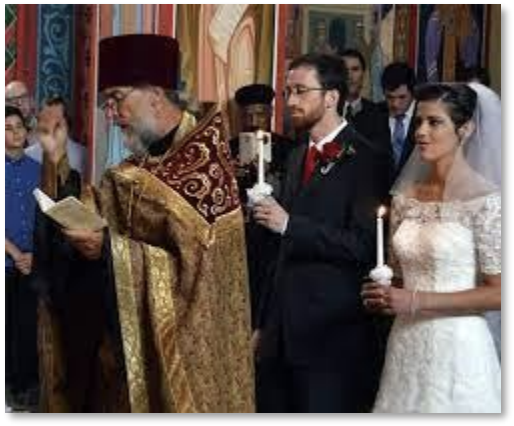Holy Matrimony
That our current sacramental rite of matrimony is the product of long development can be seen by reflecting on the simple fact that in the days of the apostles and beyond, there was no church rite of matrimony. When two Christians wanted to marry each other in (say) the second century they simply agreed to live together as a married couple, registered their marriage, and then came to church and had Holy Communion together like they did every other Sunday. In the Roman world, marriage consisted of the mutual consent of the partners. No third party, or ceremony, or witnesses were legally required. Christians did not invent a marriage ceremony to fill this vacuum—they simply accepted that this was how people, including themselves, got married. There was no special rite used which made their marriage a Christian marriage—Christian marriage existed because marriage existed in society and some of the married persons were Christians, not because the Christians were married in a special ceremony. Indeed, one anonymous early church writer in his Epistle to Diognetus expressly says that Christians marry in the same way as everyone else does.
This does not mean that the Church did not have its own understanding of Christian marriage, or that it did not regard marriage differently than the world did. The Church’s understanding of Christian marriage was actually quite different from that of the world and involved a life-long union in Christ with no possibility of divorce. Since all Christians lived to serve Christ, their marriages also were meant to reveal and express the Kingdom of God. But this different understanding did not express itself in a special ceremony in those early days.
Obviously, the assembled church community would want to celebrate the new couple’s joy, and so during the Eucharist the celebrant might offer a special prayer or blessing for the new couple. In the fourth century one hears of the Church accepting the use of floral crowns for the new couple, though previously it had frowned upon these things as pagan fripperies. Chrysostom, ever the pastoral preacher, suggests that the floral crowns should be regarded as crowns of victory over the passions, to celebrate the couple’s intact chastity. But though these crowns may have been popular with those getting married, they were not required.
In the late ninth century, one could become married either through a blessing or by crowning or by simple mutual agreement. The creation of a marriage ceremony came only after the ninth century, when the State gave the Church the difficult responsibility for all marriages in the (by then) Christianized Roman Empire, regardless of whether those being married were communicants. But in all cases, Christian marriage was sealed by the Eucharist, because the Eucharist was for Christians the source of all saving grace.
It was only in the beginning of the tenth century that one first hears of a marriage service apart from the Eucharist. Now those ineligible to receive the Eucharist (such as those entering into a mixed marriage) were still to be married by the Church, which then had to devise a new ceremony. It is this ceremony which the Orthodox Church uses today.
The wedding service as presently constituted consists of two parts: the betrothal (when the couple get engaged), and the crowning (when the couple, having concluded the period of betrothal, are married). Given that during the time of betrothal the couple had all the responsibility of mutual fidelity to each other and none of the joys of shared conjugal life, there was all sorts of incentive to make the time between betrothal and crowning as short as possible.

The betrothal consists of the mutual agreement of each party to marry the other (the legal requirement for all marriage), which is expressed in the giving of rings. The man gives his bride a ring, and the woman gives her groom one too, each one placing it on the fourth finger of the right hand as the hand of honour (note: not the left hand, as in the west). There are no vows needed to express this mutual agreement; the exchange of rings express their wordless and beautiful consent.
After the betrothal comes the crowning. The bridal pair stands together in the center of the nave, since their union expresses the eternal union between Christ and his bride, the Church. The priest places crowns on the heads of both bride and groom and prays that God Himself will crown them—not with flowers, but with glory and honour. After this the couple share a single cup of wine as an image of their shared joy and intimacy, an intimacy (and cup) which they will share with no one else.
Next, they take their first steps together as a married couple, as the priest leads them three times around a table with the Gospel upon it, and the choir sings hymns of praise to God. This circular procession around the Gospel shows how they must keep Christ at the center of their married life. Throughout all the service the priest prays for the couple, asking God’s blessing upon them.
Thus, a Christian marriage is quite different from a secular marriage. Couples not married in Church but by a civil functionary such as a justice of the peace are, of course, still married. But these secular marriages will be different than the marriages of devout Christians. “For me to live is Christ,” said St. Paul (Phil 1:21), and for a Christian life has no other purpose than to glorify the Lord. Because of this, the marriages of Christians have no other purpose than to glorify Christ also. All the joys in marriage—shared sexuality, the blessing of children, long life—are received as gifts from him, and call forth thanksgiving. Husband and wife regard each other as Christ’s gifts. This means that they must treat each other with respect and kindness, serving each other in love, with life-long commitment and fidelity to the other.